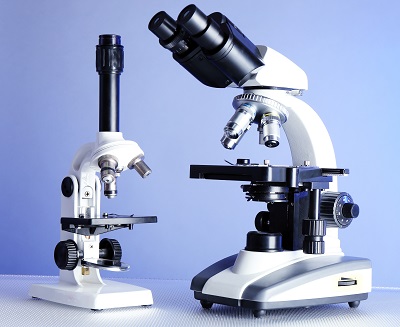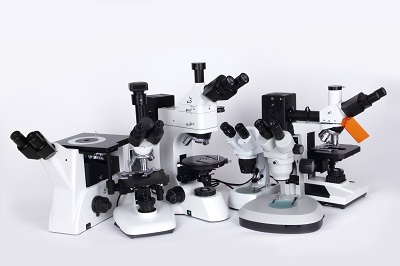Knowing how to choose the ideal microscope for your needs can be difficult. Buying a suitable microscope depends on how you want to use it and your budget. For example, suppose you plan to use a microscope for research purposes. In that case, purchasing a high-end model is the best idea. However, if you only need a basic microscope for school projects or a hobby, it’s OK to buy a cheaper one.

Researchers and scientists use microscopes to study cells and microscopic particles under a magnifying glass. The microscope works using a series of lenses to focus light onto a slide containing samples. These could contain cells, small objects, insects, tissue samples, liquids, or specimens. The magnification and high resolution allow researchers to see minute details that would otherwise be impossible to detect.
Purchasing a quality microscope can be a significant investment. So, to help you make an informed choice, this guide will help you know how to choose the best microscope to buy.
The Essential Features Of A Good Microscope
When looking for a microscope, the essential features to look for are excellent resolution, stability, light intensity, and a suitable magnification range. In addition, it is a good idea to have one with exchangeable lenses. The “160mm” standard ensures you have a wide range of options to make adjustments in the future.
For most home applications, a high-quality stereo microscope is a great choice. These allow you to examine objects such as stamps, coins, rock samples, or opaque specimens in detail. The reason is that they use reflected illumination and light, which bounce off the samples to create the image.
However, a compound microscope is best for more complex lab work involving liquids, biological research, cells, bacteria, parasites, or tissue. Samples are prepared on a slide, and illumination below the slide creates the image.
Top tip when buying a compound microscope: Don’t buy one offering magnification power over 1000x as these microscopes typically have low resolution. Most professional microscopes have a resolution of 60x; however, up to 400x is also acceptable in some circumstances.
Two Types Of Microscope — Stereo vs. Compound
When choosing a quality microscope for your hobby or research, the primary consideration is to decide on the type — if you need a compound microscope or stereo microscope. So, what is the difference?
Stereo Microscope
A stereo microscope is a precision tool used to examine objects up close. The microscope allows the user to view three-dimensional images of objects. Typically, magnification ranges are from 10x to 40x. A stereo microscope is usually used in manufacturing, quality assurance, coin collecting, science and high school dissections. In addition, they are used for examining samples where light can’t pass through the object.
Typical uses for a stereo microscope: flowers, circuit boards, small mammal anatomy, coins, small metal or plastic parts.
Compound Microscope
A compound microscope is a tool used by scientists to examine microscopic objects such as bacteria or viruses. These microscopes are often used in schools, vet clinics, laboratories, pathology, histology, or viewing live organisms under magnification.
A slide must be prepared for viewing by placing the sample on a glass slide then placing a cover slide on top. In schools, pre-prepared slides are typically used to eliminate the preparation process. Researchers, students, and scientists usually use a compound microscope to view samples invisible to the naked eye. Magnification is most commonly 40x, 100x, or up to 400x.
How To Choose The Ideal Microscope

Stereo and compound microscopes typically come in three different types — monocular, binocular, or trinocular. In other words, it has either one or two eyepieces, or it has two eyepieces with a trinocular port for photographing microscopic images. Considering which type is best depends on several factors.
Here Are Some Considerations When Buying A Microscope:
- Magnification—It’s crucial to get a microscope with the required magnification level. Typically, binocular compound microscopes have higher magnification and resolution than stereo ones.
- Usage—You should consider buying binoculars if you plan to use your microscope regularly. With a binocular microscope, you’ll enjoy better vision than with a monocular type with a single eyepiece. However, A monocular microscope is often easier for young children to handle than binoculars.
- Budget—A monocular microscope is typically the cheapest type of microscope, even if you buy a professional one. The most expensive kinds are trinocular.
- Application—The most critical consideration before buying a microscope is its purpose. A binocular stereo microscope is best for viewing small objects close up. However, if you need to examine minute specimens in a lab setting, the compound type of scope is the way to go. Then you need to decide if you need to photograph the object.
Essential Factors In Choosing A Suitable Microscope
There are other things to think about after deciding on a stereo or compound microscope and the number of eyepieces you require. After all, a microscope can be an expensive tool; therefore, you must ensure you get one that will last for many years.
Construction Quality
The first consideration is how well the microscope is made. But to buy a quality microscope, it’s not always necessary to choose the most expensive. Many affordable microscopes have good optics, ergonomic design and are highly reliable. However, it’s good to avoid cheap imports or from little-known companies. While it’s not necessary to buy from big brands like Olympus, Nikon, Leica, or Zeiss, you should avoid cheap “department store” microscopes.
Optical Quality

The standard of optics to look for is an achromatic lens. This type of lens ensures the microscope produces a much flatter image. Poor optics result in an image that appears as if viewed through a curved surface. To get a flat image, the microscope must be corrected for chromatic aberration. This is where achromatic lenses are necessary.
Additionally, make sure that the microscope has objectives that are DIN (Deutsche Industrial Norman). This means that you can interchange the objective lenses with other microscopes or replace them if necessary.
Lastly, when it comes to optics, you should consider the width of the eyepiece. Typically, the larger the eyepiece, the easier the viewing. However, a wider lens results in reduced magnification. So, if you want more magnification, you need a microscope with a smaller eyepiece.
Type Of Illumination
Illumination is a critical consideration of choosing a suitable microscope. Traditionally, the best microscopes used halogen lighting. However, modern, high-quality microscopes use LED lighting. This is economical and provides excellent illumination. On the other hand, the cheapest entry-level scopes use tungsten lighting.
Here are the four types of illumination in microscopes.
- Halogen illumination—This type of lighting is used in most microscopes because they produce a very bright, white light. Halogen scopes tend to be fitted with a dimmer switch, reducing both brightness and heat.
- LED lighting—LED is quickly becoming the industry standard. Their low energy consumption makes them ideal for use in laboratories. LED lights also last a long time, and they emit a cool white light, helping preserve specimens.
- Fluorescent—Fluorescent microscopes are becoming increasingly uncommon. However, they are still suitable for the home or school environment.
- Tungsten—Avoid buying a microscope with tungsten lighting at all costs.
Top tip when buying a quality microscope: Always ensure that the light source (LED or halogen) is dimmable. This feature is necessary to examine a range of objects without causing eye strain.
Diaphragm
Microscopes have a diaphragm located between the objective lens and the eyepiece. This allows you to control the amount of light that reaches your eye. The diaphragm is a crucial piece of the scope because it affects image sharpness and depth of field.
Here is information on the two types of diaphragms:
- Disk diaphragm—The disk diaphragm is the most basic type used in microscopy. It consists of a flat circular plate with six holes becoming progressively smaller. These sizes range from wide open to pinhole size.
- Iris diaphragm—An iris diaphragm contains interlocking leaves. These move in a circular motion to adjust the aperture’s size — similar to how the pupil in your eye works. The best microscopes have an iris diaphragm because it has infinite settings.
Condenser
All good-quality microscopes should have a condenser. The condenser is a glass lens that gathers and focuses the light into an inverted conical shape. The result is that objects under high magnification remain in precise focus. Expensive microscopes have an adjustable condenser, typically called the “Abbe” condenser. However, if you plan to work a 400x or lower, a scope with a non-movable condenser is suitable and cheaper.
Mechanical Stage
Buying a microscope with a mechanical stage is a good idea. If the scope doesn’t have one, always purchase one that allows you to fit the mechanical stage later if necessary. The mechanical stage helps move slides back and forth and up and down using controls. This avoids the necessity of touching the slide to move it.
Buying A Microscope — In Conclusion
Microscopes are useful tools for examining small, tiny, or minute objects in incredible detail. With a quality microscope, you can observe features—literally microscopic features—that would otherwise be impossible.
Buy a stereo microscope if you collect stamps, small antiquities, rocks, coins, trading cards, or other small objects. Also, if you want to get kids excited about using a microscope, then a stereo one is the best option.
Buy a compound microscope if you want to study specimens on a slide. For example, a compound scope is excellent if you have a home aquarium or want to research or examine biological samples or various types of tissues or fluids.
